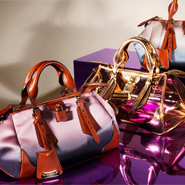
Fueled by current consumption habits and key global markets, luxury goods revenues could grow as much as 50 percent faster than the global gross domestic product, according to a new report from Bain & Co. The spring update to the “Luxury Goods Worldwide Market Study,” presented at a conference hosted by Italian luxury goods trade association Fondazione Altagamma, forecasts that the luxury goods segment will experience a 4-5 percent growth in 2013 and a 5-6 percent annual growth average until 2015. Leather goods and other accessories are expected to grow faster than other categories such as apparel and watches. “Although the global economy isn’t necessarily healthy, luxury will continue to outpace any other category,” said Chris Ramey, president of Affluent Insights, Miami, FL. “And since luxury is strong, in that are many opportunities if you understand the market properly. “It’s about the tactics, it’s about connecting with your customers on a one-to-one basis and it’s about ensuring quality and selling quality,” he said. “It is about being customer-centric, not company- or brand-centric.” Mr. Ramey is not affiliated with Bain, but agreed to comment as an industry expert. Bain & Co. was not available for comment before press deadline. The management consultancy’s Luxury Goods Worldwide Market Study analyzes the world’s leading luxury goods companies and brands and was first published in 2000. Billions and growing Global luxury goods revenues are expected to total more than $322 billion by 2015, according to the report. Last year, luxury goods revenues grew by 10 percent – as reported at current exchange rates – but this year the segment is expected to experience 4-5 percent growth. The luxury goods market is also expected to have grown five times as large in the 30 years from 1995-2025. The report confirmed key drivers of global luxury goods revenues. There are ten times as many HENRY consumers – high earnings, not rich yet – than there are ultra-affluent consumers in the world, making this group of growing importance to luxury goods marketers. This was confirmed in a recent report from Unity Marketing that found that consumers who are increasing their spending are in the HENRY group and make $100,000-249,999 per year. There are 10 HENRY households for every ultra-affluent household (see story). Additionally, absolute-luxury items – those with no visible logo and made with the highest quality and craftsmanship – are the bestselling luxury goods category. Indeed, a recent report from the Luxury Institute asked affluent consumers with a household income of at least $150,000 what differentiates luxury from mainstream and 60 percent said quality. Among this portion were many respondents on the higher end of wealth and income (see story). The report projects that leather goods and accessories will continue to grow faster than other categories, while watch purchases have been on the decline as retailers de-stock and Chinese luxury consumption slows. Also, the cosmetics category is expected to grow in emerging market, but slow in mature markets. Where in the world Factors in each global market have resulted in different growth expectations for luxury goods consumption throughout the world. In the United States, growth is expected due to high affluent consumer confidence levels, new store openings in cities and more cross-channel brand campaigns that link in-store shopping with ecommerce. Twelve percent sales growth is expected in Central and South America, especially in Brazil and Mexico. All together, the Americas should see a 5-7 percent growth. In the Eastern Hemisphere, new store openings and strength in tier-two markets will cause an expected 20 percent growth in Southeast Asia. China, as a whole, should experience 7 percent growth in luxury goods revenues, while Japan has 5 percent growth. Last year's Luxury Goods Worldwide Market Study found that Chinese consumers, including their spending as tourists, accounted for 20 percent of global luxury sales while all of the Asian consumer base accounted for 50 percent (see story). Europe, due to slow tourism as travelers choose new destinations as well as a slowdown in spending among its citizens, is expected to have up to 2 percent growth. Finally, the Middle East will grow steadily, driven by luxury goods sales and tourism to Dubai. This year brought a more even distribution of global growth for the luxury goods sector, according to Bain. “Perhaps the report further illustrates that global campaigns in the future will not be as successful as those that are highly targeted based on the growth of the market and the condition of that market,” Affluent Insights’ Mr. Ramey said. “What resonates with an emerging Chinese middle class market won’t be the same that resonates with Europeans, even though they are buying the same brand,” he said. “It will take the tenacity of strong leaders to future-segment their brands in order to reach each market effectively, because the buyers are culturally different and they are in different places – intellectually.” Final Take Tricia Carr, associate reporter on Luxury Daily, New York
